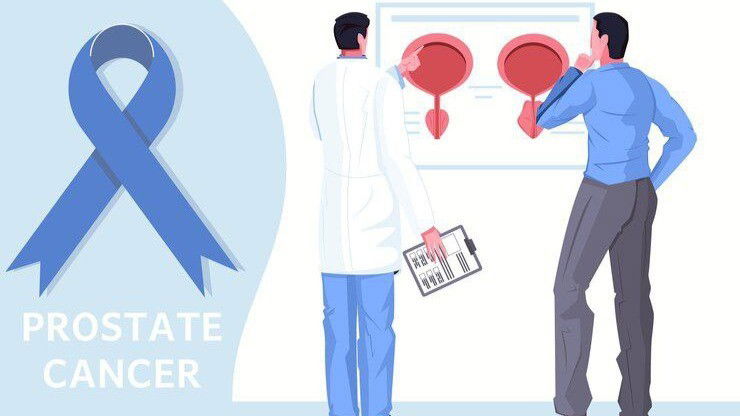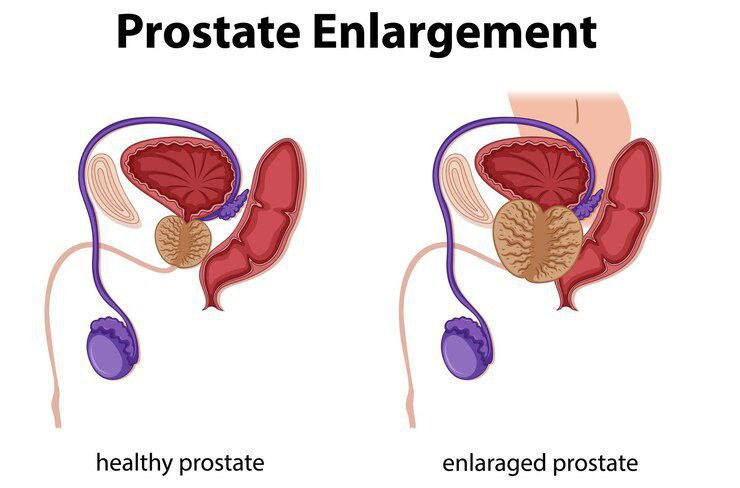Overview of Prostate Cancer

Author: Nr. Chika Jones RN, RM, RPHN, BNSC
Reviewed by Dr Azuka Chinweokwu Ezeike, MBBS, FWACS, FMCOG, MSc (PH)
Highlights
Prostate cancer is the second most common cancer affecting men globally.
- African men are more likely to develop cancer from an early onset.
- Prostate cancer has four stages.
- Regular screening improves treatment outcomes.
Overview of Prostate Cancer
What is Prostate Cancer?
Prostate cancer develops when cells in the prostate begin to grow out of control, forming malignant tumours [1].
The Affected Organ
The prostate is the organ affected by prostate cancer. It is a gland found only in men and is the size of a walnut. It is located below the bladder. The functions of the prostate gland are:
- Seminal Fluid Production: It produces seminal fluid.
- Regulates Urine Flow: The prostate gland helps control urine flow by regulating bladder pressure through the relaxation and contraction of the bladder.
- Hormone Metabolism: The prostate converts the male hormone testosterone into an active form.
- Assist in Ejaculation: The muscles surrounding the prostate forcefully expel semen during ejaculation [2].
Location of the Prostate Gland
The prostate is below the bladder (an organ that stores urine before it is expelled through the urethra). It is in front of the Rectum. The urethra, a tube that carries semen and urine to the penis, runs through the centre of the prostate.
How Does Prostate Cancer Develop?
There is no known cause of prostate cancer but several risk factors that could develop prostate cancer.
- Age: Men over 50 are at higher risk of developing prostate cancer, regardless of their family history [3].
- Family History: Having a father or brother with prostate cancer increases your risk by 2 to 4 times.
- Genetic Changes: Research evidence shows that men from families with a history of breast cancer may develop prostate cancer because of inherited abnormality in genes such as BRCA1 and BRCA2.
This results from changes in the genes that the offspring can inherit from their parents. For example, genetic changes in BRCA1 or BRCA2 lead to increased risks of prostate, breast, and ovarian cancer [1]. A mutation in the BRCA2 gene significantly increases a man's risk of developing prostate cancer.
- Ethnicity: African men develop prostate cancer at a younger age, and the disease is more aggressive (more likely to spread to surrounding cells and recur after treatment). This leads to poorer health outcomes.
- Diet: Research has reported that the intake of high red and processed meats, eggs, dairy products, and fish with a limited intake of fruits and vegetables, may increase the risk of prostate cancer. However, the exact link is not clearly stated[3].
How Common is Prostate Cancer?
- Prostate cancer is the fourth most common cancer worldwide.
- It is the 2nd most common cancer affecting men.
- Prostate cancer is more prevalent among men in sub-Saharan Africa [4]. It accounted for 1.24% of total deaths among men in sub-Saharan Africa in 2016.
Research estimates that by 2030, 1.7 million recent cases of prostate cancer will be recorded, also with 499,000 deaths if the trend is not curbed.
Stages and Progression of Prostate Cancer
Once diagnosed, tests are carried out to know if the cancer is within the prostate gland or has spread. Staging refers to assessing the tumour size and the extent of spread.
The stage of prostate cancer is essential, as it helps healthcare professionals determine appropriate treatment options [5]. Early prostate cancer may not show symptoms, but individuals may experience certain symptoms as the disease advances, such as:
- Bone pain
- Getting tired easily
- Nausea and vomiting
- Rapid weight loss
- Frequent urination or pain or difficulty while urinating.
Prostate Cancer Staging (TNM System)
Prostate cancer can be staged using the TNM system. The TNM system considers:
- Tumour Size (T): Describes the tumour (cancer) size and the extent of the spread. It can be placed between T1 and T4.
- T1 to T2: Cancer is confined to the prostate.
- T3 to T4: Cancer cells have spread to other areas of the body.
- Lymph Node Involvement (N): This checks if the cancer has spread to the lymph nodes. Lymph nodes are small bean-shaped structures found under the neck, underarms, groin, etc. It is part of the immune system that filters harmful substances.
N has two stages, N0 and N1
- N0 means cancer cells have not spread to nearby lymph nodes.
- N1 means that lymph nodes near the prostate have cancer cells.
- Metastasis (M): It indicates If the cancer has spread to a distinct part of the body.
Metastasis has two stages - M0 and M1.
- M0: No distant spread.
- M1: The cancer cells have spread to other regions of the body. M1 has three sub-stages: M1a, M1b, and M1c.
- M1a: The cancer cells have spread beyond the pelvis. The prostate gland is found in the pelvic region.
- M1b: Cancer cells affect the bones.
- M1c: Cancer spreads to other body parts like lungs, livers, kidneys, etc.
It classifies prostate cancer into 4 stages;
- Stage I: Early stage and localized cancer. The cancer is small and within the prostate gland only. However, with timely intervention nearly all men with stage I prostate cancer can expect a successful recovery.
- Stage II: The cancer remains within the prostate. The survival rate for stage 2 is still high, nearing 100%. The main difference between stage I and II is that stage II has a higher chance of the cancer spreading to surrounding regions.
- Stage III: Stage I cancer is confined within the prostate. Stage II cancer is confined within the prostate, but there is a risk it could spread more than stage I.
Meanwhile, stage III has a high probability of cancer spreading compared to other stages. It may have spread or not. If the cancer has not spread, there is a 100% chance of survival.
However, if spread occurs, the cancer is no longer confined to the prostate gland, but it is locally advanced (cancer spreads to surrounding tissues and lymph nodes).
- Stage IV: This is the most advanced stage. The cancer has spread to distant organs. This leads to a drop in survival rate.
How Does Prostate Cancer Progress?
It progresses in two stages: localized and advanced.
- Localized: This is an early stage of prostate cancer. The cancer cells are confined to the prostate gland. It is either a tumour stage I or II cancer. Under the TNM grade system.
- Advanced: This is a late-stage cancer, and it spreads to surrounding parts of the body. It can be stage III or IV cancer.
Importance of Early Detection
- Prostate cancer often shows no symptoms until it has reached an advanced stage.
- Regular screening can detect prostate cancer before it reaches an advanced stage.
Prostate cancer can be detected early through screening:
The screening methods include:
- High PSA (Prostate-Specific Antigen): PSA is a protein produced by the prostate gland. PSA is a blood test that detects the amount of PSA in the body.
A high level of PSA may indicate prostate cancer. A PSA level above 4.0 ng/mL would require further testing like a biopsy;
- Digital rectal examination: This is when the doctor checks the size of the prostate through the anus.
After prostate cancer is diagnosed, Pathologists use the Gleason score.to determine the speed of growth of the cancer
The benefits of early detection include:
- Early detection is essential for treatment and management by healthcare professionals.
- It increases the chances for successful treatment and recovery.
- It improves quality of life. Prostate cancer can lead to complications such as sexual and urinary problems [4].
Key Takeaways
Prostate cancer is a significant health problem that affects men. Hence, it is vital to understand prostate cancer, the causes, the stages, and the progression of the disease. Regular screening methods, like PSA tests and biopsies, can help detect prostate cancer before it reaches an advanced stage.
Published March 14, 2024
References
1. American Cancer Society. What Is Prostate Cancer? [Internet]. www.cancer.org. 2019. Available from: https://www.cancer.org/cancer/types/prostate-cancer/about/what-is-prostate-cancer.html
2. Institute for Quality and Efficiency in Health Care. How does the prostate work? [Internet]. Nih.gov. Institute for Quality and Efficiency in Health Care (IQWiG); 2022. Available from: https://www.ncbi.nlm.nih.gov/books/NBK279291/
3.Nanda S, Dash DK, Sahu AK, Wael Mahmoud Aboulthana, Devi P. Prostate Cancer: A Short Discussion. 2022 Mar 26;17(1):12–9. Available from: https://www.researchgate.net/publication/359518950_Prostate_Cancer_A_Short_Discussion
4. Anaba EA. What Do You Know About Prostate Cancer? [Internet]. 2019. Available from: https://www.researchgate.net/publication/337903811_What_Do_You_Know_About_Prostate_Cancer
5. Castillejos-Molina RA, Gabilondo-Navarro FB. Prostate cancer. Salud Pública de México. 2016 Mar;58(2):279–84. Available from: https://www.researchgate.net/publication/306549143_Prostate_cancer
